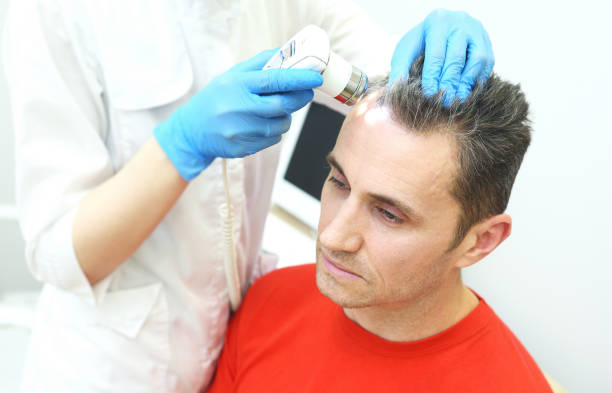Top Scalp Psoriasis Diagnosis and Treatment Choices in the United States for 2025
Nearly half of U.S. psoriasis patients experience scalp involvement, which can seriously reduce quality of life. This article explains how to recognize scalp psoriasis, identify common triggers, and review diagnosis plus medical and lifestyle treatment options to help manage symptoms.

What Is Scalp Psoriasis and How Does It Affect You?
Scalp psoriasis is a persistent inflammatory skin disorder caused by an overactive immune response that accelerates skin cell production, leading to thick, scaly areas on the scalp. In the United States, around 45 to 56 percent of those with psoriasis have scalp involvement, which may extend beyond the scalp to the hairline, forehead, neck, and the skin around the ears. This condition is characterized by alternating periods of flare-ups and remission.
Symptoms range from minor, dandruff-like scaling to severe thick, silver-white plaques that cause itching, discomfort, and in extreme situations, temporary hair loss. Given its visibility and chronic irritation, scalp psoriasis can profoundly impact emotional health and overall quality of life.
Accurate Diagnosis Is Crucial for Effective Treatment
Because scalp psoriasis can resemble other scalp conditions such as seborrheic dermatitis, eczema, or dandruff, an accurate diagnosis is vital. Dermatologists conduct comprehensive clinical evaluations including:
- Examining the scalp, other skin areas, and nails
- Reviewing patient medical history, symptom patterns, and triggers
- Possibly performing a skin biopsy to confirm the diagnosis and exclude other conditions
Early dermatological assessment also often involves screening for psoriatic arthritis, which affects roughly one-third of psoriasis patients. Prompt diagnosis helps improve treatment outcomes and allows for the monitoring of related health risks like cardiovascular disease and depression.
Identifying Symptoms and Triggers
Symptoms of scalp psoriasis can differ in severity and appearance:
- Mild cases may present as fine, white scaling similar to dandruff
- Moderate to severe cases involve thick, raised, inflamed plaques topped with silvery-white scales
- Plaque color may vary (red, purple, brown), especially in individuals with darker skin tones
- Itching, burning, and discomfort that can disrupt everyday activities
- Severe flare-ups may cause temporary hair thinning or loss
Common triggers include:
- Emotional stress and strain
- Skin injuries or infections
- Lifestyle influences such as smoking and obesity
- Environmental irritants and certain medications
Controlling these triggers through lifestyle modifications and preventive steps can lessen the frequency and severity of flare-ups.
First-Line Options: Topical Treatments
Topical therapies remain the foundation for treating mild to moderate scalp psoriasis. These include:
- Over-the-counter shampoos and products containing salicylic acid or coal/pine tar, which aid in loosening scales and reducing inflammation
- Prescription corticosteroid shampoos, foams, gels, and creams (e.g., clobetasol, betamethasone) that target redness and scaling
- Topical retinoids such as tazarotene, which slow skin cell growth but require cautious use due to irritation potential
Since hair can complicate application, foams, solutions, and oils are often preferred depending on hair type and patient comfort. Regular follow-up with a dermatologist ensures correct use and monitors for side effects like skin thinning.
Phototherapy: A Valuable Alternative for Moderate to Severe Cases
Ultraviolet (UV) light therapy, or phototherapy, offers an effective treatment especially when topical methods are insufficient. Specialized handheld devices with comb attachments deliver controlled UV light directly onto the scalp to:
- Reduce inflammation and scaling
- Slow the excessive skin cell production
- Improve lesions with fewer systemic side effects
Phototherapy may be used alone or in combination with topical therapies and requires consistent sessions supervised by medical professionals.
Systemic Treatments for Severe or Treatment-Resistant Psoriasis
For patients with moderate to severe scalp psoriasis or those unresponsive to topical and phototherapy, systemic treatments could be necessary. These comprise:
- Biologic drugs that target specific immune system components to interrupt the disease process; they often improve symptoms within weeks
- Traditional systemic medications like methotrexate and cyclosporine, which suppress the immune system but necessitate careful monitoring due to possible serious side effects
These systemic options are prescribed and overseen by dermatologists or rheumatologists to strike a balance between effectiveness and safety, including screening for infections and regular medical evaluations.
Personalized Treatment Plans and Regular Monitoring
Effective management of scalp psoriasis requires an individualized strategy. Dermatologists adapt treatment plans based on:
- Severity and scope of scalp involvement
- Patient preferences regarding formulation types and tolerability
- Hair characteristics and lifestyle considerations
- Co-existing conditions such as psoriatic arthritis or metabolic disorders
Combination therapies and rotation of treatments frequently optimize results and minimize adverse effects. Continuous follow-up facilitates timely adjustments and helps monitor overall health risks linked to psoriasis.
Enhancing Scalp Health through Lifestyle and Self-Care
Alongside medical treatments, lifestyle and self-care greatly contribute to controlling scalp psoriasis:
- Consistent moisturizing with creams, ointments, or oils maintains skin hydration and decreases scaling
- Choosing appropriate shampoos containing coal tar or salicylic acid can soothe symptoms
- Avoiding smoking and maintaining a healthy weight help reduce inflammation and improve treatment responses
- Stress reduction techniques support immune system balance
- Routine health checkups assist in early identification and management of related comorbidities
Dedicating oneself to ongoing care and lifestyle adjustment plays a significant role in achieving long-term symptom relief and improving quality of life.
Conclusion
In 2025, scalp psoriasis management in the United States involves precise diagnosis, varied treatment options, and patient-tailored care approaches. From topical medications and phototherapy to systemic therapies, multiple paths exist to control symptoms and manage triggers effectively. Understanding these choices and maintaining regular healthcare engagement empowers individuals to achieve improved scalp health and overall wellbeing.
Sources
- National Psoriasis Foundation. Scalp Psoriasis. https://www.psoriasis.org/scalp/
- Mayo Clinic. Psoriasis: Diagnosis and Treatment. https://www.mayoclinic.org/diseases-conditions/psoriasis/diagnosis-treatment/drc-20355845
- Harvard Health Publishing. Scalp Psoriasis: What to Know About This Uncomfortable Inflammatory Skin Condition. https://www.health.harvard.edu/diseases-and-conditions/scalp-psoriasis-what-to-know-about-this-uncomfortable-inflammatory-skin-condition
Disclaimer: Treatment availability and practices may vary by location and healthcare provider. It is recommended to consult a qualified healthcare professional to determine the best options tailored to individual needs.




